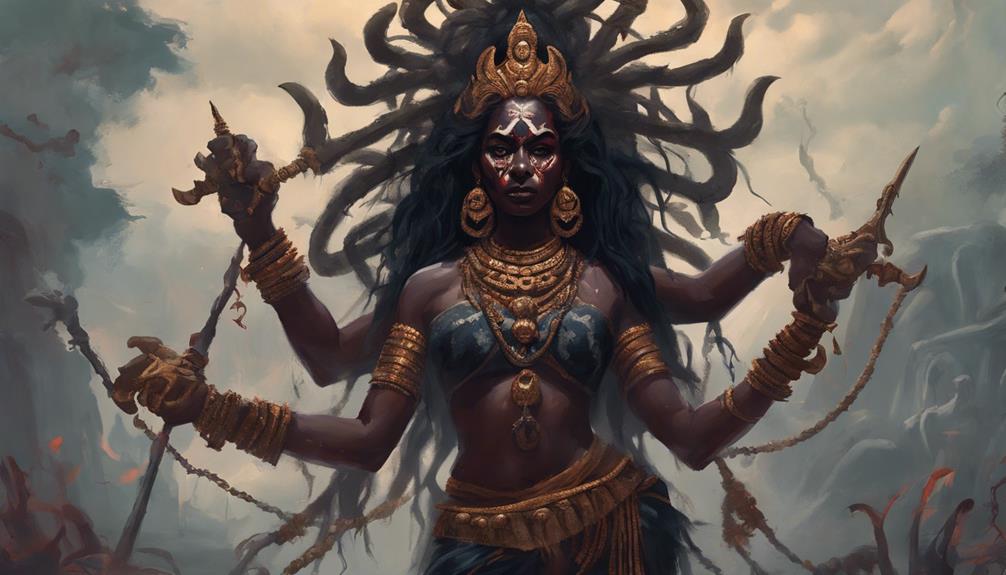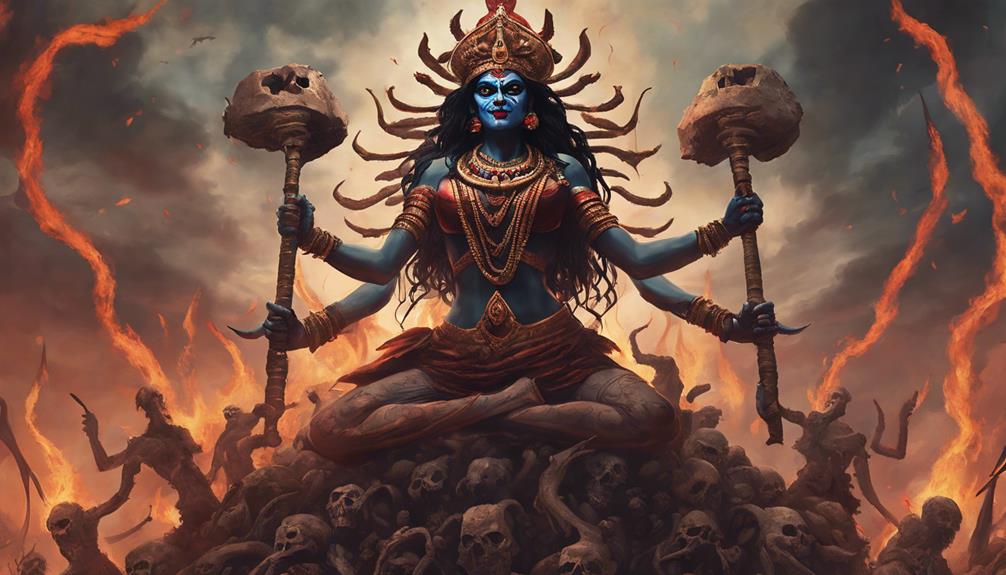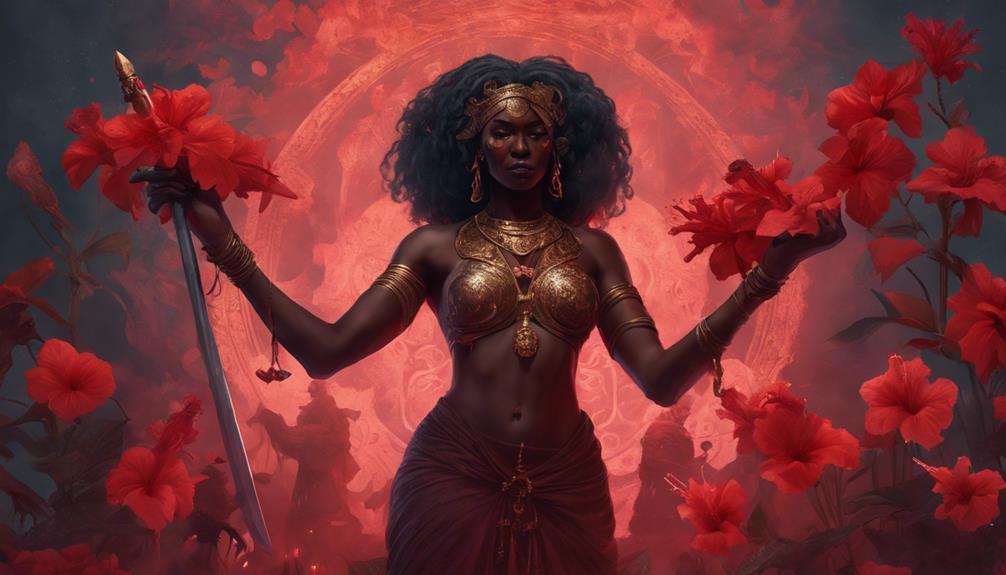In worshipping the Goddess Kali, devotees engage in rituals and offerings like flowers and incense to show devotion and seek protection. Kali symbolizes the eternal cycle of life, death, and rebirth, embodying both destruction and creation. Her dark complexion represents the incomprehensible nature of the divine, while her depictions standing on Lord Shiva signify dominance over time. Evoke Kali's power through elaborate ceremonies and connect with her fierce yet compassionate nature. Understanding the rich symbolism and practices surrounding Goddess Kali reveals the depth of her significance and influence in Hindu spirituality.
Table of Contents
Key Takeaways
- Rituals involve offerings like flowers, incense, and fruits as signs of devotion and respect.
- Prayers seek protection and express devotion to Goddess Kali.
- Establish spiritual connection through elaborate ceremonies to invoke Kali's blessings.
- Kali symbolizes destruction, creation, and ultimate protection against evil forces.
- Cultural significance extends to empowerment, liberation, and embracing the cycle of life, death, and rebirth.
Origins of Goddess Kali
The origins of Goddess Kali can be traced back to ancient Hindu mythology, where she's revered as a powerful and fearsome deity associated with destruction and transformation. Kali's symbolism and significance are deeply rooted in the concept of time and change. She's often depicted with a garland of skulls, symbolizing the eternal cycle of life, death, and rebirth.
Kali's historical origins and evolution can be linked to the Vedic texts where she's mentioned as a goddess of time, a bringer of death, and a symbol of ultimate reality. Over time, Kali evolved into a more complex figure, embodying both destruction and creation. Her dark complexion represents the infinite and incomprehensible nature of the divine.
As Hindu beliefs and practices developed, Kali became associated with empowerment, liberation, and the fierce protection of her devotees. The evolution of Kali reflects the multifaceted nature of existence and the interconnectedness of life's cycles.
Forms and Depictions of Kali
When exploring the forms and depictions of Goddess Kali, it's imperative to contemplate the symbolic representations attributed to her, the mythological stories that surround her existence, and the profound cultural significance she holds within Hindu traditions.
Each aspect offers a unique insight into the multifaceted nature of Kali, shedding light on her roles as a symbol of empowerment, a deity of destruction and creation, and a divine force representing time and change.
Symbolic Representations of Kali
Various artistic representations of Kali, the fierce and powerful Hindu goddess, encompass a wide range of forms and depictions that symbolize her multifaceted nature. Kali's symbolic representations often highlight her role in both destruction and creation, reflecting the cyclical nature of life.
Iconic imagery of Kali typically includes her dark complexion, wild hair, multiple arms holding weapons, and a garland of skulls. These visual elements convey her fearsome appearance and her role as a protector against evil forces. Depictions of Kali standing on top of her husband, Lord Shiva, symbolize her dominance over time and death.
Through these artistic representations, devotees are reminded of Kali's strength, ferocity, and divine presence in both the material and spiritual domains.
Mythological Stories About Kali
Investigating the mythological stories surrounding Kali reveals a rich tapestry of narratives that explore the diverse forms and depictions of this formidable Hindu goddess. In folklore tales, Kali is depicted as a fierce warrior, often seen with a sword and a severed head, symbolizing her power over ego and ignorance. These stories emphasize her role in destroying evil forces and protecting devotees.
Rituals dedicated to Kali often involve offerings of blood, incense, and animal sacrifices, symbolizing her fierce nature and the cycle of life and death. Kali's divine symbols, such as the skull garland and the trident, further highlight her connection to destruction and renewal. Through these mythological tales, devotees gain insight into Kali's multifaceted nature and her significance in Hindu mythology.
Cultural Significance of Kali
Exploring the diverse forms and depictions of Goddess Kali reveals a profound cultural significance deeply rooted in Hindu mythology and symbolism. Kali is often depicted with multiple arms, each carrying symbolic items such as a sword and a severed head, representing her role as a destroyer of evil forces.
Modern interpretations of Kali emphasize her fierce nature as a symbol of empowerment and liberation. Her global impact extends beyond traditional Hindu worship, resonating with people worldwide who admire her strength and fearlessness.
The various artistic representations of Kali, from ancient sculptures to contemporary artworks, showcase her timeless relevance and the enduring fascination she holds for those seeking courage and protection.
Rituals and Offerings in Worship
Engage in the sacred act of worship by meticulously preparing ritual offerings to honor Goddess Kali. Offerings and prayers play an essential role in Kali worship, symbolizing devotion, gratitude, and seeking blessings. Rituals and ceremonies associated with Kali worship are rich in symbolism and tradition, reflecting the complexity of the deity's divine nature.
Devotees often offer flowers, incense, fruits, and sweets to Goddess Kali as a sign of respect and adoration. These offerings are made with deep reverence and are believed to please the goddess, fostering a closer connection between the worshipper and the divine. Additionally, prayers recited during these rituals serve as a medium for devotees to communicate their desires, seek protection, and express their devotion to Goddess Kali.
The elaborate rituals and ceremonies performed in Kali worship aren't only a means of showing reverence but also a way to invoke the goddess's presence and receive her blessings. Through these sacred acts, devotees establish a spiritual connection with Goddess Kali, seeking her guidance and protection in their lives.
Symbolism of Kalis Iconography

The symbolism within the iconography of Goddess Kali explores deeply into the intricate layers of meaning and representation associated with her divine form. Iconography analysis of Kali reveals profound spiritual meanings intertwined with her appearance.
Kali's dark complexion symbolizes the eternal night, representing the transcendence of time and the ultimate reality beyond human comprehension. The garland of skulls around her neck signifies the liberation from the cycle of life and death, highlighting the impermanence of physical existence. Her multiple arms suggest her boundless power and ability to investigate, emphasizing her role as a cosmic force.
The sword and severed head in her hands represent the cutting of ignorance and ego, enabling spiritual growth and enlightenment. Kali's fierce expression and stance embody the destruction of evil forces and the protection of her devotees. Through artistic interpretations, Kali's iconography serves as a visual language conveying profound philosophical and metaphysical concepts, inviting worshippers to explore the depths of spiritual reflection and understanding.
Kalis Role in Hindu Mythology
Within Hindu mythology, Goddess Kali's role is deeply intertwined with cosmic battles, creation narratives, and the embodiment of primal energy. Kali's influence can be seen in her representation as the fierce and powerful goddess who destroys evil forces to maintain cosmic order. She's often depicted adorned with skulls and standing on the body of Lord Shiva, symbolizing the eternal dance of creation and destruction.
Kali's spiritual significance lies in her ability to annihilate ignorance and ego, leading devotees towards spiritual liberation. Her dark complexion represents the infinite potential of the void from which all creation emerges. The garland of severed heads around her neck symbolizes the ego's defeat and the transcendence of worldly attachments.
In Hindu mythology, Kali is revered as the ultimate protector against evil forces and the embodiment of time, change, and the inevitability of death. Her role as a fierce warrior goddess highlights the constant battle between good and evil, emphasizing the necessity of destruction for new creation to take place.
Kalis Associations With Destruction

Kali's associations with destruction stem from her portrayal as a transformative force in Hindu mythology, embodying the necessary cycle of annihilation for creation and renewal to occur. Devotees engage in various rituals to honor this aspect of Kali, recognizing that destruction is an integral part of the cosmic process. Through these devotional practices, worshippers seek to acknowledge the impermanence of the material world and the inevitability of change.
The cultural significance of Kali's associations with destruction lies in her symbolism as a fierce yet compassionate deity. Her destructive nature isn't one of malevolence but of necessity, symbolizing the constant cycle of birth, death, and rebirth. By embracing Kali's destructive aspect, followers learn to let go of attachments and ego, paving the way for spiritual growth and transformation.
In essence, Kali's role as a destroyer isn't about causing harm but about clearing the path for new beginnings. Through rituals and meditative practices centered on her destructive energy, worshippers aim to transcend the limitations of the material world and connect with the eternal cycle of creation and renewal that Kali embodies.
Kalis Connections to Creation
Symbolizing the primordial forces of creation, Goddess Kali's connections to the cosmic cycle of birth and renewal are deeply rooted in Hindu mythology and spiritual practices. In Hindu creation myths, Kali is often portrayed as the ultimate source of cosmic energy from which the universe emerges. She represents the raw power that brings forth existence from the void and is viewed as the divine mother who births all creation. Kali's association with creation goes beyond just physical birth; she's also linked to the continuous process of renewal and transformation in the universe.
Within the framework of cosmic energy, Kali embodies the dynamic interplay of destruction and creation. While she's known for her fierce and destructive nature, this aspect is essential for clearing the way for new beginnings. Kali's role in creation myths signifies the cyclical nature of existence, where death and rebirth are intertwined in the eternal dance of the cosmos. By understanding Kali's connections to creation, one can appreciate the profound symbolism she holds in Hindu spirituality as a catalyst for both transformation and evolution.
Festivals and Celebrations of Kali

Festivals and celebrations dedicated to Goddess Kali are rich in symbolism and rituals, each holding profound significance in the worship of the deity.
These occasions often involve elaborate ceremonies, including a variety of offerings and devotional practices that serve to honor and invoke the power of Kali.
Understanding the traditional customs and observances during these festivals can provide insight into the complex tapestry of beliefs and cultural expressions surrounding the veneration of Goddess Kali.
Rituals and Offerings
In the intricate tapestry of rituals and offerings dedicated to Goddess Kali, a profound and ancient tradition unfolds, encompassing diverse expressions of devotion and celebration.
Sacred rituals play a central role in the worship of Kali, with practices varying across regions but often involving chanting of mantras, performing aarti (light offering), and offering flowers, fruits, and sweets. Traditional offerings such as incense, vermilion, and coconut are presented to the goddess as symbols of reverence and devotion.
Festivals like Kali Puja and Navratri are celebrated with great fervor, where devotees engage in elaborate ceremonies to honor the fierce yet compassionate nature of Kali. These rituals and offerings serve as a conduit for devotees to connect with the divine presence of Goddess Kali and seek her blessings in their lives.
Significance in Worship
The celebration of Goddess Kali through festivals and ceremonies holds a profound significance in the worship practices dedicated to her. Ritual practices during these festivals often involve intense forms of devotion, including meditation techniques aimed at connecting with Kali's fierce yet compassionate energy.
Sacred texts and pivotal contexts play an important role in shaping these celebrations, providing a rich tapestry of stories and beliefs that deepen the devotee's understanding of Kali's symbolism. The festivals and celebrations of Kali serve as a time for reflection, purification, and renewal.
They offer a space for devotees to immerse themselves in the divine presence of Kali, seeking her blessings for protection, strength, and transformation in their lives. Through these rituals and festivities, the worship of Goddess Kali continues to thrive, carrying forward ancient traditions into the present day.
Devotional Practices and Mantras
Devotees of Goddess Kali engage in profound devotional practices centered around the chanting of powerful mantras as a means of connecting with her divine energy. Chanting mantras holds significant importance in Kali worship, serving as a gateway for devotees to establish a deep spiritual connection with the Goddess. The repetitive recitation of specific mantras dedicated to Kali is believed to invoke her presence, fostering a sense of closeness and intimacy with the deity. These sacred rituals aren't merely mechanical utterances but are imbued with intense devotion and reverence, reflecting the devotee's earnest desire to merge with Kali's divine essence.
The act of chanting mantras during worship serves as a transformative practice, allowing individuals to transcend the limitations of the physical domain and access the higher planes of consciousness where Kali's energy is believed to reside. Through the vibrational power of these mantras, devotees seek to attune themselves to the primal cosmic energy that Goddess Kali embodies, ultimately leading to spiritual growth and self-realization.
Frequently Asked Questions
What Is the Significance of Kali's Dark Complexion and Fierce Appearance in Her Worship?
When considering the significance of Kali's dark complexion and fierce appearance in worship rituals, it is important to explore the symbolism behind it. These aspects embody her power, strength, and ability to eliminate evil forces.
How Does the Worship of Kali Differ in Different Regions of India?
In India, regional variations in Kali worship influence ritual practices. From Bengal's intense rituals to South India's more subdued ceremonies, the diverse ways Kali is revered reflect cultural nuances and interpretations of her power.
Are There Any Specific Taboos or Restrictions to Be Followed While Worshipping Goddess Kali?
When worshipping Goddess Kali, observe specific taboos and restrictions. Respect cultural beliefs by following ritual practices and religious customs. These rules hold spiritual significance and guarantee proper reverence towards the deity in various regions of India.
How Does Kali's Role as a Destroyer Align With Her Role as a Protector in Hindu Mythology?
In Hindu mythology, Kali's duality as a destroyer and protector reflects the cyclical nature of life and death. Her symbolism embodies both fear and devotion, illustrating the transformative power of destruction and creation within the cosmic order.
Can Non-Hindus Participate in Kali Worship and Celebrations?
Yes, non-Hindus can respectfully participate in Kali worship and celebrations, showing cultural sensitivity and honoring religious boundaries. This inclusivity allows for spiritual exploration and understanding, fostering mutual respect and interfaith dialogue.
Conclusion
To sum up, the worship of Goddess Kali is a deeply symbolic and complex practice that spans centuries in Hindu mythology. Through various forms, rituals, and offerings, practitioners honor Kali as a fierce yet compassionate deity who embodies both destruction and creation.
Her iconography and associations with power, time, and transformation make her a significant figure in spiritual traditions. The festivals and devotional practices dedicated to Kali continue to inspire devotion and reverence among followers worldwide.